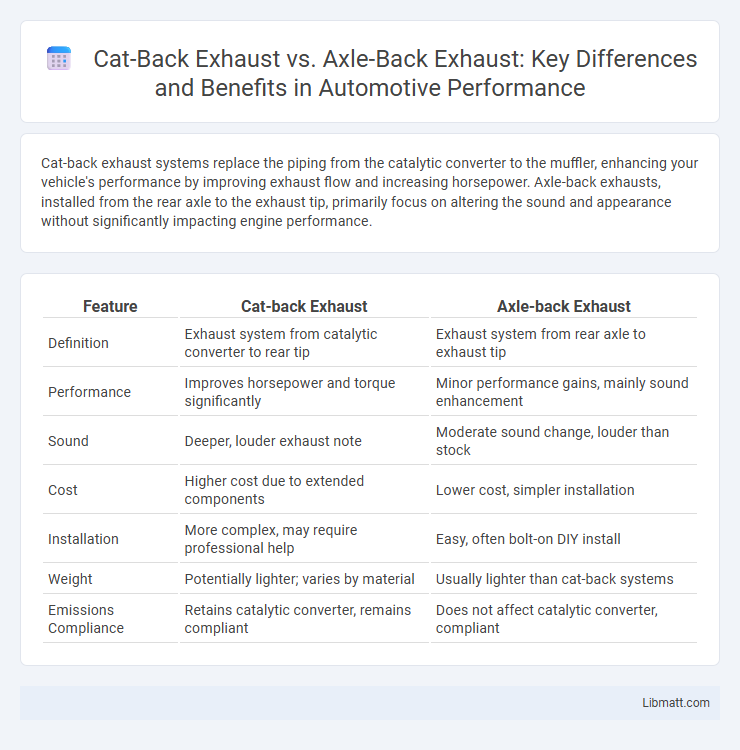Cat-back exhaust systems replace the piping from the catalytic converter to the muffler, enhancing your vehicle's performance by improving exhaust flow and increasing horsepower. Axle-back exhausts, installed from the rear axle to the exhaust tip, primarily focus on altering the sound and appearance without significantly impacting engine performance.
Table of Comparison
| Feature | Cat-back Exhaust | Axle-back Exhaust |
|---|---|---|
| Definition | Exhaust system from catalytic converter to rear tip | Exhaust system from rear axle to exhaust tip |
| Performance | Improves horsepower and torque significantly | Minor performance gains, mainly sound enhancement |
| Sound | Deeper, louder exhaust note | Moderate sound change, louder than stock |
| Cost | Higher cost due to extended components | Lower cost, simpler installation |
| Installation | More complex, may require professional help | Easy, often bolt-on DIY install |
| Weight | Potentially lighter; varies by material | Usually lighter than cat-back systems |
| Emissions Compliance | Retains catalytic converter, remains compliant | Does not affect catalytic converter, compliant |
Introduction to Cat-Back and Axle-Back Exhaust Systems
Cat-back exhaust systems extend from the catalytic converter to the rear of the vehicle, replacing components like the mid-pipe, muffler, and tailpipe to enhance performance and sound. Axle-back exhaust systems replace the parts from the rear axle to the exhaust tip, focusing primarily on the muffler and tailpipe for a simpler upgrade. Your choice between these systems depends on desired performance gains, sound preferences, and budget considerations.
What is a Cat-Back Exhaust System?
A cat-back exhaust system refers to the section of the exhaust that runs from the catalytic converter to the rear of the vehicle, including the muffler and tailpipe. This setup improves exhaust flow, enhances engine performance, and often produces a deeper exhaust sound compared to stock systems. Choosing the right cat-back exhaust system can optimize your car's power and fuel efficiency while meeting emission standards.
What is an Axle-Back Exhaust System?
An axle-back exhaust system replaces the exhaust components from the rear axle to the tailpipe, focusing on improving sound and aesthetics without major performance changes. It is simpler and often more affordable than a cat-back system, which extends from the catalytic converter to the tailpipe. Your choice depends on whether you want a subtle exhaust tone upgrade or more extensive performance enhancements.
Key Differences Between Cat-Back and Axle-Back Systems
Cat-back exhaust systems replace components from the catalytic converter to the exhaust tip, enhancing overall exhaust flow and performance by upgrading the mid-pipe, muffler, and tailpipe. Axle-back exhaust systems only replace the section from the rear axle to the exhaust tip, focusing mainly on muffler and tailpipe changes for improved sound without significantly altering exhaust flow. Cat-back systems typically provide more horsepower gains and a deeper exhaust tone, whereas axle-back setups are easier to install and primarily affect noise levels.
Performance Benefits: Cat-Back vs Axle-Back
Cat-back exhaust systems improve engine performance by enhancing exhaust gas flow from the catalytic converter to the rear, resulting in increased horsepower and torque. Axle-back exhausts primarily influence sound and aesthetics, offering minimal gains in performance as they replace components only from the rear axle to the exhaust tip. Overall, cat-back systems deliver more significant performance benefits compared to axle-back setups due to reduced backpressure and improved exhaust scavenging.
Sound and Noise Levels Compared
Cat-back exhaust systems generally produce a louder, deeper, and more aggressive sound due to the replacement of the exhaust system from the catalytic converter back, enhancing exhaust flow and resonance. Axle-back exhausts, installed only from the rear axle to the exhaust tip, offer a milder sound increase, preserving quieter noise levels while providing a subtle exhaust tone upgrade. Choosing the right system depends on your preference for sound intensity and legal noise restrictions in your area.
Installation Process: Cat-Back vs Axle-Back
The installation process for a cat-back exhaust typically involves replacing the system from the catalytic converter to the rear, requiring more time and mechanical expertise compared to an axle-back exhaust. Axle-back exhaust systems are easier to install, as they only replace the exhaust components from the rear axle to the muffler, often allowing for a straightforward bolt-on upgrade. Your choice depends on your skill level and whether you seek a comprehensive exhaust upgrade or a simpler, faster modification.
Cost Comparison: Which Is More Affordable?
Cat-back exhaust systems typically cost more than axle-back exhausts due to their extended length and involvement with the catalytic converter outlet, often ranging between $500 to $1,500 installed, whereas axle-back systems are generally more affordable, priced around $300 to $700. Your choice depends on budget and desired performance since cat-back systems offer improved horsepower and sound, justifying the higher cost for many enthusiasts. Axle-back exhausts remain a cost-effective option focused on tailpipe and muffler upgrades without extensive modifications.
Which Exhaust System Should You Choose?
Choosing between a cat-back exhaust and an axle-back exhaust depends on your performance goals and budget. A cat-back exhaust replaces the system from the catalytic converter backward, offering improved horse power, torque, and a more aggressive sound, making it ideal for enthusiasts seeking noticeable gains and enhanced engine efficiency. An axle-back exhaust, installed from the rear axle to the exhaust tip, is generally less expensive, provides a modest sound upgrade, and is easier to install, suitable for drivers prioritizing a sporty exhaust note without significant performance changes.
Conclusion: Cat-Back vs Axle-Back Exhaust Systems
Cat-back exhaust systems replace the exhaust from the catalytic converter to the rear of the vehicle, offering improved performance, sound enhancement, and potential fuel efficiency gains. Axle-back exhaust systems only replace the portion from the rear axle to the exhaust tip, primarily altering the exhaust note without significant performance improvements. Choosing between cat-back and axle-back depends on desired sound quality, performance goals, and budget, with cat-back systems providing a more comprehensive upgrade.
Cat-back exhaust vs Axle-back exhaust Infographic

 libmatt.com
libmatt.com